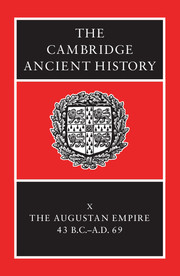17 - The origins and spread of Christianity
from PART IV - ROMAN SOCIETY AND CULTURE UNDER THE JULIO-CLAUDIANS
Published online by Cambridge University Press: 28 March 2008
Summary
ORIGINS AND SPREAD
Renewal and reform movements in Palestinian Judaism are well represented in the first-century generations preceding the fall of Jerusalem and the destruction of the Temple A.D. 70; they flourished in a religious context which lacked sharply defined doctrines and practices, where there was no clearly accepted orthodoxy or authority. Not only was there a range of distinguishable sects (the most notable being, of course, the Pharisees, the Sadducees and the Essenes – but there were a number of others, most prominent among which was the ‘Philosophy of Judas’ with his politically active followers, the Sicarii and Zealots); there was, in addition, a bewildering array of individual ascetics, prophets and preachers who frequently drew in great crowds and commanded dedicated followings. What they often shared in common was a passion for the Torah and the Temple but what often distinguished them was their precise definition, in ritual practice, of purity and sacrifice. Messianic expectations were in the air – but they were by no means shared equally by all, nor was there even agreement on the nature of those messianic hopes. Ethical debate went hand-in-hand with debate over ritual and ceremony, diet and custom, oral law and written law, the interpretation of the Torah; it was all part of the same process of drawing the boundaries between purity and pollution, holiness and sin, in defining for Israel the will of God. Doctrinal debate there certainly was, especially centred on the after-life, immortality and resurrection, but the debates at least shared the same religious and cultural preoccupations.
- Type
- Chapter
- Information
- The Cambridge Ancient History , pp. 848 - 872Publisher: Cambridge University PressPrint publication year: 1996
References
- 3
- Cited by

